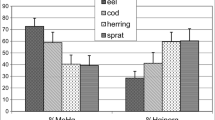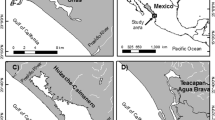Abstract
An assessment of mercury (Hg) accumulation in fish from the Tagus River aquatic system (central Spain), which has been influenced by pollution from industrial and urban development, was performed. Total Hg (THg), inorganic Hg (IHg), and monomethylmercury (MMHg) were determined in muscle and liver of different fish species, including Cyprinus carpio, Ameiurus melas, and Chondrostoma miegii, sampled from three locations. Although concentrations of THg and Hg species showed wide variability among the fish species, they were also found to be considerably dependent on location and fish tissue. Relative contents of MMHg to THg in muscle varied from 60 to 88%, whereas those found in liver ranged from 7 to 59%. Mean THg concentrations ranged from 126 to 810 ng/g (dry weight [dw]) in liver and from 159 to 1057 ng/g dw in muscle. Therefore, the mean THg concentration in all fish muscle samples was far lower than the maximum residue level recommended by the European Union for fishery products. Nevertheless, the concentrations of Hg in fish muscle reported in this study were somewhat increased compared with other areas geographically distant from most major anthropogenic Hg sources and, in some cases, even greater than those previously reported elsewhere in more polluted areas. In contrast, Hg contents in liver were lower than those found in Hg-contaminated areas, but they were within the range found in other areas exposed to diffuse sources of pollution by Hg. Thus, this article provides an overview of the concentration and distribution of Hg species in fish muscle and liver tissues samples taken from a freshwater system in the Mediterranean River basin.



Similar content being viewed by others
References
Berzas Nevado JJ, Rodríguez Martín-Doimeadios RC, Guzmán Bernardo FJ, Jiménez Moreno M (2005) Determination of mercury species in fish reference materials by gas chromatography-atomic fluorescence detection after closed-vessel microwave-assisted extraction. J Chromatogr A 1093:21–28
Berzas Nevado JJ, Rodríguez Martín-Doimeadios RC, Guzmán Bernardo FJ, Jiménez Moreno M, Ortega Tardío S, Sánchez-Herrera Fornieles MM et al (2009) Integrated pollution evaluation of the Tagus River in Central Spain. Environ Monit Assess 156:461–477
Bowles KC, Apte SC, Maher WA, Kawei M, Smith R (2001) Bioaccumulation and biomagnification of mercury in Lake Murray, Papua New Guinea. Can J Fish Aquat Sci 58:888–897
Burger J, Gaines KF, Boring CS, Stephens WL, Snodgrass J, Gochfeld M (2001) Mercury and selenium in fish from the Savannah river: species, trophic level and locational differences. Environ Res Section A 87:108–118
Cizdziel JV, Hinners TA, Pollard JE, Heithmar EM, Cross CL (2002) Mercury concentrations in fish from Lake Mead, USA, related to fish size, condition, trophic level, location, and consumption risk. Arch Environ Con Toxicol 43:193–200
Cizdziel J, Hinners T, Cross C, Pollard J (2003) Distribution of mercury in the tissues of five species of freshwater fish from Lake Mead, USA. J Environ Monit 5:802–807
Cleary D, Thornton I, Brown N, Kazantzis G, Delves T, Worthington S (1994) Mercury in Brazil. Nature 369:613–614
Coelho JP, Rosa M, Pereira ME, Duarte AC, Pardal MA (2006) Pattern and annual rates of Scrobicularia plana mercury bioaccumulation in a human induced mercury gradient (Ria de Aveiro, Portugal). Estuar Coast Shelf Sci 69:629–635
Cossa D, Martin JM, Sanjuan J (1994) Dimethylmercury formation in the Alboran Sea. Mar Pollut Bull 28:381–384
Dixon R, Jones B (1994) Mercury concentrations in stomach contents and muscle of five species from the northeast coast of England. Mar Pollut Bull 28:741–745
Gammons CH, Slotton DG, Gerbrandt B, Weight W, Young CA, McNearny RL et al (2006) Mercury concentrations of fish, river water and sediment in the Río Ramis-Lake Tititaca watershed, Peru. Sci Total Environ 368:637–648
Goede RW, Barton BA (1990) Organismic indices and an autopsy-based assessment as indicators of health and condition of fish. Am Fish Soc Symp 8:93–108
Goldstein RM, Brigham ME, Stauffer JC (1996) Comparison of mercury concentrations in liver, muscle, whole bodies and composites of fish from the Red River of the North. Can J Fish Aquat Sci 53:244–252
Havelkova M, Dusek L, Némethova D, Poleszczuk G, Svobodova Z (2008) Comparison of mercury distribution between liver and muscle―a biomonitoring of fish from lightly and heavily contaminated localities. Sensors 8:4095–4109
Henny CJ, Hill EF, Hoffman DJ, Spalding MG, Grove RA (2002) Nineteenth century mercury―hazard to wading birds and cormorants of the Carson River, Nevada. Ecotoxicology 11:213–231
Houserova P, Kuban V, Kracmar S, Sitko J (2007) Total mercury and mercury species in birds and fish in an aquatic ecosystem in the Czech Republic. Environ Pollut 145:185–194
Huggett DB, Stevens JA, Allgood JC, Lutken CB, Grace CA, Benson WH (2001) Mercury in sediment and fish from North Mississippi lakes. Chemosphere 42:923–929
Jin L, Liang L, Jiang G, Xu Y (2006) Methylmercury, total mercury and total selenium in four common freshwater fish species from Ya-Er Lake, China. Environ Geochem Health 28:401–407
Kannan K, Smith RG, Lee RF, Windom HL, Heitmuller PT, Macauley JM et al (1998) Distribution of total mercury and methyl mercury in water, sediment, and fish from south Florida estuaries. Arch Environ Contam Toxicol 34:109–118
Linde AR, Sanchez-Galan S, Garcia-Vazquez E (2004) Heavy metal contamination of European eel (Anguilla anguilla) and brown trout (Salmo trutta) caught in wild ecosystems in Spain. J Food Protect 67:2332–2336
Marsalek P, Svobodova Z, Randak T (2007) The content of total mercury in common carp from selected Czech ponds. Aquacult Int 3–4:299–304
Mason RP, Reinfelder JR, Morel FMM (1995) Bioaccumulation of mercury and methylmercury. Water Air Soil Pollut 80:915–921
Mieiro CL, Pacheco M, Pereira ME, Duarte AC (2009) Mercury distribution in key tissues of fish (Liza aurata) inhabiting a contaminated estuary―implications for human and ecosystem health risk assessment. J Environ Monit 11:1004–1012
Official Journal of the European Union (2006) Commission regulation no. 1881/2006. Setting maximum levels for certain contaminants in foodstuffs
OSPAR (2004) OSPAR/ICES Workshop on the evaluation and update of background reference concentrations (B/RCs) and ecotoxicological assessment criteria (EACs) and how these assessment tools should be used in assessing contaminants in water, sediment and biota. Hazardous Substances Series, No. 214. ISBN 1-904426-52-2
Raldúa D, Díez S, Bayona JM, Barceló D (2007) Mercury levels and liver pathology in feral fish living in the vicinity of a mercury cell chlor-alkali factory. Chemosphere 66:1217–1225
Régine MB, Gilles D, Yannick D, Alain B (2006) Mercury distribution in fish organs and food regimes: significant relationships from twelve species collected in French Guiana (Amazonian basin). Sci Total Environ 368:262–270
Sager DR (2004) Mercury in tissues of selected estuarine fishes from minimally impacted bays of coastal Texas. Bull Environ Contam Toxicol 72:149–156
Schaefer JK, Yagi J, Reinfelder JR, Cardona T, Ellickson KM, Tel-Or S et al (2004) Role of the bacterial organomercury lyase (MerB) in controlling methyl mercury accumulation in mercury-contaminated natural waters. Environ Sci Technol 38:4304–4311
Stafford CP, Haines TA (2001) Mercury contamination and growth rate in two piscivore populations. Environ Toxicol Chem 20:2099–2101
Stein ED, Cohen Y, Winer AM (1996) Environmental distribution and speciation of mercury compounds. Crit Rev Environ Sci Technol 26:1–13
Storelli MM, Storelli A, Giacominell-Stuffler R, Marcotrigiano GO (2005) Mercury speciation in the muscle of two commercially important fish, hake (Merluccius merluccius) and striped mullet (Mullus barbatus) from the Mediterranean Sea: estimated weekly intake. Food Chem 89:295–300
Svobodova Z, Zlabek V, Celechovska O, Randak T, Machova J, Kolarova J (2002) Content of metals in tissues of marketable common carp and in bottom sediments of selected ponds of South and West Bohemia. Czech J Anim Sci 47:339–350
Ullrich SM, Tanton TW, Abdrashitova SA (2001) Mercury in the aquatic environment: a review of factors affecting methylation. Crit Rev Environ Sci Technol 31:241–293
United States Environmental Protection Agency (2001) Water quality criterion for the protection of human health: methylmercury. United States Environmental Protection Agency, Water Quality Criterion for the Protection of Human Health: Methylmercury
Vandal GM, Mason RP, Fitzgerald WF (1991) Cycling of volatile mercury in temperate lakes. Water Air Soil Pollut 56:791–803
Voegborlo RB, Matsuyama A, Adimado AA, Akagi H (2011) Determination of methylmercury in marine and freshwater fish in Ghana using a combined technique of dithizone extraction and gas-liquid chromatography with electron capture detection. Food Chem 124:1244–1248
Watras CJ, Huckabee JW (1994) Mercury pollution: integration and synthesis. Lewis, Boca Raton, FL
Weber JH, Evans R, Jones SH, Hines ME (1998) Conversion of mercury (II) into mercury (0), monomethylmercury cation and dimethylmercury in saltmarsh sediment slurries. Chemosphere 36:1669–1687
World Health Organization (2003) Evaluation of certain food additives and contaminants. Sixty-first meeting of the Joint FAO/WHO expert committee on food additives: summary and conclusions
Acknowledgments
M. J. Moreno acknowledges the Junta de Comunidades de Castilla-La Mancha for doctoral financial support (D.O.C.M. 08/01/03).
Author information
Authors and Affiliations
Corresponding author
Rights and permissions
About this article
Cite this article
Nevado, J.J.B., Martín-Doimeadios, R.C.R., Bernardo, F.J.G. et al. Mercury Speciation in Fish Tissues from a Mediterranean River Basin: The Tagus River (Central Spain) as a Case Study. Arch Environ Contam Toxicol 61, 642–652 (2011). https://doi.org/10.1007/s00244-011-9666-y
Received:
Accepted:
Published:
Issue Date:
DOI: https://doi.org/10.1007/s00244-011-9666-y




